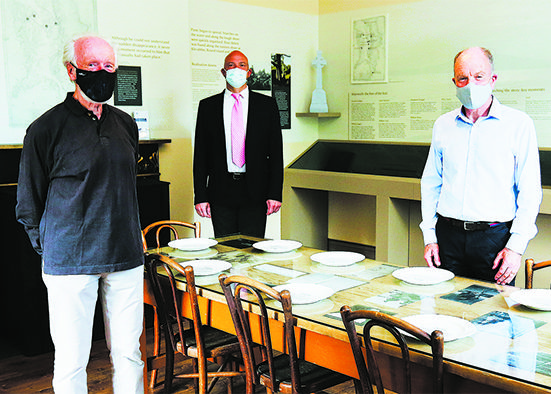Mystery of Strangford Lough boating disaster
Mystery of Strangford Lough boating disaster
7 July 2021

A CHANCE discovery by a group of walkers has shed new light on a 19th century boating disaster on Strangford Lough.
The 1895 tragedy claimed the lives of eight people and to this day remains the single biggest loss of life on the lough.
The sad story and the painstaking detective work which has brought it to light now forms a new exhibition which has opened at Mount Stewart, formally the home of the Londonderry family and now owned by the National Trust.
A memorial to the disaster still stands on the lough shore and was spotted by the group near Mount Stewart in 2015.
The cross was carved with an inion recording that it was erected by the Marquis and Marchioness of Londonderry in “affectionate remembrance” of Eliza Taunt, Elizabeth Dougal, Joseph Grainge, William Rowe, William and Robert Hagan, their faithful servants, drowned in Strangford Lough on April 11, 1895.
The four servants from Mount Stewart and two local boatmen, together with two servants visiting from Florence Court House in Fermanagh, Jane Cheshire and William Start, perished together.
They had had set off on a picnic outing on the lough aboard the Mountstewart, Lady Londonderry’s yacht and never returned. Only four of the bodies were ever recovered.
At the discovery of the memorial, the group knew nothing of the tragedy — but they decided to find out more.
Delving into the archives to uncover the truth behind what happened to the Mountstewart yacht, the team of seven volunteers spent over six years travelling around the country on a voyage of discovery.
From newspaper reports, family archives at Mount Stewart and public archives and other sources, they traced descendants of those who died, including one lady in California whose great grandfather was Joseph Grainge, house steward at Mount Stewart.
Research has retrieved details of the event which was major news in its day with coverage in papers across the UK. The Marquis of Londonderry said the people lost were friends as much as servants, reflecting the impact it had on the household. Queen Victoria is recorded as having sent a telegram of condolences, although the telegram has not yet been found.
The group also used technology in their research. Drones, sonar and 3D imaging allowed them to plot the route taken by Mountstewart and produce a ‘probability box’ — an area within which the boat is likely to have sunk.
Although the wreck has not yet been located, the search is narrowing. They have identified a number of anomalies on the lough bed, mostly in depth of about 12-15 metres, although one is in the main channel at 27 metres. The team hope to explore them in more detail and discover the final resting place of the Mountstewart.
The work has led to an exhibition called ‘The Mystery of the Mountstewart’ which answers some of the questions surrounding the fateful event.
“We have all been on an incredible journey and it’s not over yet,” said John Orr, a member of the research team.
“To date we have uncovered a great deal, and through our research we have discovered images, artefacts and documents.
“We’ve been able to put faces to the names and identify the backgrounds and personalities of those who lost their lives. We’ve learnt a lot about the people involved, we’ve got to know them and what they did in their work in the houses in the late 1890s.”
The research group made some important discoveries, including the existence of the unmarked grave of William Start in a churchyard in Portaferry and an original oar from the boat in a farmer’s barn on the Mount Stewart estate.
Frances Bailey, senior national curator for the National Trust, said: “This project has given us a glimpse into the lives of those lost and of those who searched and grieved for them in a powerful and sensitive way and provides an insight into their working environment as well as their private lives and families.
“It has opened a window onto life at Mount Stewart in the late 19th century and greatly enriched our understanding and appreciation of the mutually respectful, even friendly, relationships between the Londonderrys and their staff.
“This research project was born from a chance discovery by a wonderful team of volunteers. It was fed by their enthusiasm, deep interest and empathy for those lost and those left behind. It was delivered with great professionalism and integrity.
“I can’t thank them enough for the work they have done and the rigour with which they have pursued it.”
Christopher Warleigh-Lack, Property Curator at Mount Stewart said: “This exhibition, the Mystery of the Mountstewart, is testament to the importance of research. It tells a story that had become almost forgotten, which piece by piece has been revealed and shared. What we see behind this exhibition is a long period of dedication from a group of committed volunteers, all bringing their own skills, experience, and nuance to the story. And for that, we are grateful.
Paul Mullan, Northern Ireland of the National Lottery Heritage Fund, said: “This new National Trust exhibition highlights the intrinsic role that heritage plays in all of our lives. No matter where we come from, or what we do, we all have a story to tell. And although, this story is a tragic one, it’s an important part of local history that should be preserved.
“It also demonstrates how heritage can bring people together and it’s great that even more people will have the opportunity to better understand their local heritage through this project.”
The Mystery of the Mountstewart exhibition is now open at Mount Stewart.


